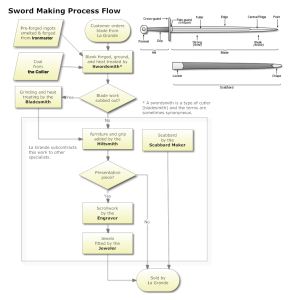Doesn’t seem possible, right? I mean assembly lines in the European Dark Ages? Yes.
Technological innovation did not come to a halt after the fall of the Western Roman Empire in the 5th Century AD. It crawled, in some ways went backward, and in other ways forward.
We need to define terms first. The time period I’m talking about is between the 5th to the 15th centuries. The location is Europe. An assembly-line is a process by which a series of workers and machines manufacture and assemble an identical product.
 In researching the history behind my new novel “The Healing Stone,” I was shocked to find that a blacksmith does not make swords. Who did? A swordsmith? Yes, and no. The work was split up among specialists. In my story, a female swordsmith nicknamed “La Grande” forges the blades and subcontracts the work to other specialists so she can sell them. The diagram to the left shows the process.
In researching the history behind my new novel “The Healing Stone,” I was shocked to find that a blacksmith does not make swords. Who did? A swordsmith? Yes, and no. The work was split up among specialists. In my story, a female swordsmith nicknamed “La Grande” forges the blades and subcontracts the work to other specialists so she can sell them. The diagram to the left shows the process.
The image of a lonely monk-like craftsman hammering out a complete sword by hand in a dark monastery or alley is wrong. Some may have been crafted this way, but in larger cities like Toledo, an industry forged the blade.
For more information see:
How Swords Were Made
Engineering the Medieval Achievement



